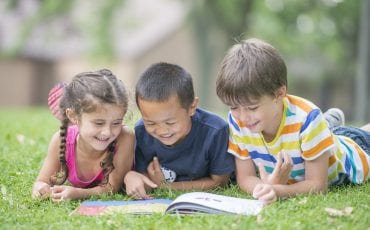Timeless Terms That Define Growth and Learning

Covered Bridge Montessori School
Maria Montessori opened her first school in Italy in 1907, making her philosophies about how children learn more than 100 years old, yet they are ones that still fit in today’s world. “Montessori has stood the test of time,” says Rosanne Tricoles, Primary Montessori Curriculum Specialist at Springmont School. “It’s a very modern approach to education because the needs of kids haven’t changed.” So, how does an educational program retain its luster after all this time? The key may be in the central concepts that all Montessori schools center their students’ experiences around. Let’s explore some of these timeless terms!
Table of Contents
Freedom Within Limits
This two-sided term helps create classroom structure for students. “Students have the freedom to move around, choose what lesson they want to get out, where to sit in the classroom,” explains Tracye Marino, Head of School at the Montessori School at Emory. “They also have to work within rules and show respect by not harming a material or disturbing someone else.” She says that this give and take approach works well because students like the freedom; they follow the rules in order to enjoy the benefit.
Understanding expectations also has real academic payoffs for students. Children learn best when their minds and bodies are not stressed. “The establishment of a classroom foundation to promote respectful social interactions and strong work ethics and discipline via community collaboration and contribution allows students to be open to learning,” explains Qiu Fang, Director & Owner of Covered Bridge Montessori School.
Freedom without limits also teaches independence and problem solving. “Our students are always looking for the next challenge, asking questions, and figuring out how to do things on their own because they have this freedom,” says Marino.

Springmont School
Ground Rules
The term ground rules goes hand-in-hand with freedom within limits. General ground rules often cited inside a Montessori learning community are respect oneself, respect one another, and respect the environment. “These ground rules are modeled, reiterated and reinforced through regular encounters of experiences, scenarios, one-on-one guidance and conflict resolutions among peers,” says Fang.
The common understanding creates a sense of safety and calm in the classroom. “The students care for one another because they are in a community,” says Marino. “It’s a mutual thing for them. They all have the same ground rules, and they know how things will run, which enhances the learning experience.”
Multi-age Groupings
Montessori classes are constructed around three-year groupings of students (ages 0-3, 3-6, and then by grades as students get older). “The benefit of this is that the younger kids learn from the older kids, and older kids can be a mentor to someone younger,” says Tricoles. “Because they are in the same classroom for three years, everyone has the opportunity to take on both roles.” This also creates the opportunity to build compassion and empathy because students see the experience of others in their classroom community.
Being in a classroom where multiple levels of material are being taught has its advantages as well. “Students in Montessori programs don’t have to wait for the next age level to learn a new skill,” notes Marino. “No one tells you something isn’t ‘on age level.’ Students can go grow and learn at their own pace.”
Practical Life Activities
This term refers to things that happen in everyday life. At Montessori at Emory, children participate in the care of their classroom through practical life activities of doing dishes, caring for the plants, baking, setting the tables for lunch, sweeping the floors and more. “Each of these activities has a direct and indirect lesson,” says Marino. “Yes, they are doing something real, but they are also building fine and gross motor skills that is getting them ready for the next phases of their learning. It is all purposeful work.”
Montessori students set up their work – including activities like window washing – from left to right. This structure lays the foundation for writing, reading and math. “These practical activities help students build focus for more academic sort of work,” says Tricoles. Fang echoes this sentiment, “Practical life activities reinforce the work habits of concentration and finishing a task from beginning to end.”

Montessori School at Emory
Prepared Environment
This philosophy centers on the idea that everything in the classroom is set up for the child to succeed. “All the furniture is the right size for the students, so that they can move things around, which supports independence,” explains Tricoles. Montessori classrooms are also designed to be calm. “We don’t have a lot of stuff on the walls, which helps children focus and not be overstimulated by their environment,” she says.
Teachers and parents also play a key role in the success of prepared environments. “It is imperative that a Montessori school culture attracts same-minded individuals to promote and cherish a mindset-driven, growth-oriented community together,” says Fang.
Work Cycle
The Montessori work cycle is a three-hour (two hours for younger learners) period in which children can explore and work without interruption. “Within the work cycle, children are given one-on-one guidance with freedom to choose their work, the freedom to repeat a work until mastery, the freedom to refine and rediscover, and the freedom to move about the classroom to absorb all the elements of dynamic learning happening in and around the whole learning community,” says Fang.
“Washing windows can take 20 minutes for a 3 year old, so we want to give them as much time as possible to complete their task and have fun doing it,” says Marino. “As the teacher sees a student has mastered something, they’ll introduce something new to keep the child challenged and engaged.”
The work cycle is unique to the Montessori approach. It allows students to connect deeply with their learning and not feel the time pressure that sometimes exists in other types of learning environments.
Even after a century, parents are still seeing the benefits of Montessori’s approach for their children. From independence and compassion to exploration and focus, students in Montessori classrooms build practical and academic skills. “Montessori follows the natural curiosity of learning for children and our environment allows them to do just that,” says Marino.
-Tali Benjamin







